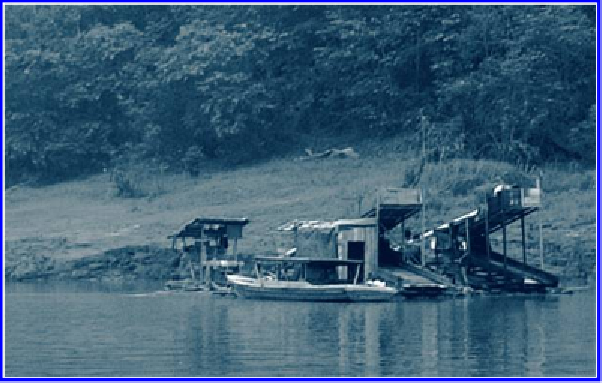Environmental Engineering Reference
In-Depth Information
FIGURE 5.9
Dredging for Gold on the Barito River
in Central Kalimantan, Indonesia
In at least one case, the government actually carries out the mining, providing ore
for treatment by local people. Similarly, as mentioned previously, companies such as
Newmont, Aneka Tambang, and Aurora Gold have voluntarily allowed small-scale
miners to exploit deposits within their tenements. It is relatively common for systematic
exploration to identify mineral deposits, which because of their small size or remoteness
from infrastructure, do not justify mining. Some of these deposits may be ideally suited to
small-scale mining, providing a potential 'win - win' situation. An extension of this situ-
ation would be if tailings from small-scale mining were then collected by the company for
re-treatment. However, many companies would be reluctant to treat wastes from small-
scale miners on the basis that they would be exposed to the associated risks and liabilities.
Modern technology has increased the range of methods available to small-scale miners.
One environmentally damaging example is hydraulic mining or sluicing, in which high pres-
sure water jets are used to excavate alluvial or oxidized ores. Another is dredging (
Figure 5.9
),
where river bed or river bank sediments are dredged from a l oating vessel. In both cases, the
excavated sediment is passed over rifl e boxes or similar sluicing arrangements to concentrate
the heavy minerals - usually gold. Panning and mercury amalgamation may also be used in
some of these operations.
Traditional Small-scale Mining
Traditional small-scale mining activities are characterized by community co-operation, a
skilled workforce, relatively high resource recovery, and stability - even in circumstances
of l uctuating prices. In fact, the best examples of traditional small-scale mining have
proved to be 'sustainable' over many generations; few corporate mining operations have
achieved comparable sustainability.
One of the best examples is the
Kankana-ey
artisanal mining community in Benguet
Province, near Baguio in the Philippines, a region of extensive small-scale and corporate
mining activity over a long period. There is evidence that these traditional gold mining
activities date back more than 800 years (Caballero 1996). A l ow chart, illustrating the
steps followed by the
Kankana-ey
in mining and processing, is shown in
Figure 5.10
.
According to Caballero, a husband and wife and their extended kin work together in
both placer and lode mining. While both men and women participate in mining, some










Search WWH ::

Custom Search